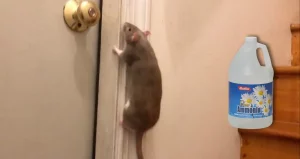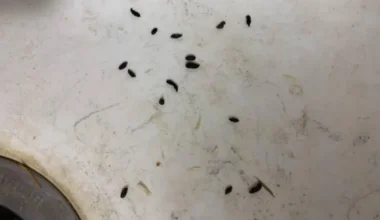There are multiple ways to deter rats from entering your residence, ammonia is one such technique. The widespread adoption of ammonia as a rodent-repellent can be attributed to its ready availability in the market and versatility in application. This article takes you through the steps to make rat poison with ammonia. But the question is whether ammonia is effective against rats or not.
The answer is affirmative, but it may not offer a long-term solution. Ammonia has a scent that repels rats, and when used correctly can keep these critters at bay for a considerable period.
How ammonia repels rats
Ammonia is a transparent gas with a discernible odor that consists of nitrogen, hydrogen, and water. It is commonly used as a component in fertilizers and cleaning formulations. The primary factor behind the rat-repelling properties of ammonia is the strong olfactory senses of rats.
Rats, being nocturnal creatures, heavily rely on their keen sense of smell to locate food sources, even in low-light conditions.¹
In addition to locating food, they employ their heightened sense of smell to detect potential threats in their surroundings. When rats encounter the scent of ammonia, it resembles the urine odor of their predators, triggering a response that signals danger. This perception of a nearby predator prompts the rats to avoid the area, rendering ammonia an effective way of deterring them.
Aside from its potent smell, ammonia can harm the respiratory systems of rats. It is a highly toxic substance for both rodents and humans. The presence of ammonia in an environment can cause damage to the trachea of rats.² Similarly, household items such as peppermint oil, castor oil, and onions can also serve as deterrents for rats due to their strong aromas, operating on the same principle as ammonia.
How to make rat poison with ammonia

Ammonia as a rat repellent can deter these pests for some time. However, before the chemical, identify the specific areas within your residence where rats are commonly found. Rats tend to nest in dark places near the walls of a house.
One prevalent method of using ammonia as a rat repellent is by directly using the chemical and pouring it along the boundaries of your house. However, if this approach is impractical, you can consider the following methods to make rat poison with ammonia:
1. Homemade Rat Poison
You’ll need the following material to create rat poison using ammonia:
- Ammonia
- 1 cup of water
- 2 tablespoons of detergent
- A bowl
For the preparation of ammonia homemade rat poison, follow the steps below:
- Mix approximately 2 cups of ammonia, 1 cup of water, and 1 tablespoon of detergent in a bowl.
- Once mixed, place this ammonia poison in areas frequented by rats.
- This method will deter rats and potentially keep them at bay for several weeks.
Note that this is only a temporary way to stop mice, which allows you ample time to explore permanent measures such as contacting your local pest professional to protect your home against rodents.
2. Ammonia-soaked cotton balls
If the idea of placing bowls of ammonia mixture around your house is not appealing, consider soaking cotton balls or rags in ammonia. You can prepare the ammonia solution as mentioned earlier and then immerse the rags or cotton balls in it for soaking. This way, you distribute the repelling scent of ammonia throughout specific areas without the need for visible bowls.
Place these ammonia-soaked rags or cotton balls around your home to seal potential entry points for rats looking to come into your home. You also create a barrier that deters their access using this method. If you intend to use this rat control method for a longer time, make sure to replace it every few weeks to ensure the continued effectiveness of the repellent.
3. Ammonia spray solution
Ammonia carries a strong and potentially lingering odor, which may be undesirable in your living environment. So, if you don’t want to stash ammonia-soaked balls or make rat poison with ammonia, consider using ammonia spray to remove smart rats.
This method may be slightly less effective but it is a suitable choice for people who dislike highly concentrated ammonia solutions present throughout their home. This method is also less risky for pets and children, compared to placing homemade ammonia poison for rats.
To repel mice with ammonia spray, transfer the previously mentioned ammonia solution into a spray bottle. Use this spray in areas where you identified rat activity to discourage their presence. Be careful when handling this chemical as ammonia can be hazardous.
Safety measures when using ammonia poison
Before you make rat poison with ammonia or use it as a rat repellent, ensure to follow all safety guidelines and take necessary precautions. The ideal safety measure is to wear NH3-rated goggles and gloves (cuffed), and be fully clothed – long sleeve shirt and pants (no shorts), according to the Minnesota Department of Agriculture.³ Never wear contact lenses while applying ammonia to get rid of rats.
Exposure to high ammonia concentrations in the air causes immediate eye, nose, throat, and respiratory tract burns. High levels of ammonia can lead to blindness, lung damage, or even death. Inhalation of lower concentrations can cause coughing, and nose and throat irritation, according to the New York Department of Health.⁴
Additionally, ensure that the chemical is kept away from any flammable materials, as it has the potential to cause explosions. Note that substances such as chlorine bleach, other halogens, and heavy metals can react unfavorably when in contact with ammonia.
Contact your local pest control company
While you can make rat poison with ammonia or use ammonia as a rat repellent, it is a temporary measure with limited effectiveness in addressing a rat infestation. For a more comprehensive and effective approach to ensure the complete elimination of rats from your premises, seek professional assistance. Pest management experts often control pests in various kinds of infestation properties, including apartment units, healthcare facilities, and hospitality establishments with effective pest control plans.
Read also: Residing in Florida? How to remove stubborn roof rats
- Norway Rats. Illinois Department of Public Health
- Ammonia Build-up in Animal Boxes and Its Effect on Rat Tracheal Epithelium. Medical Research Council Laboratory Animals Centre
- Practice Safety When Handling Anhydrous Ammonia – NH3. Minnesota Department of Agriculture
- The Facts About Ammonia. New York Department of Health






